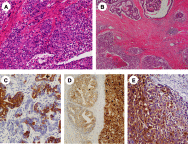Clinicopathological features and prognosis of AFP-producing colorectal cancer: a single-center analysis of 20 cases
- PMID: 31191017
- PMCID: PMC6529609
- DOI: 10.2147/CMAR.S196919
Clinicopathological features and prognosis of AFP-producing colorectal cancer: a single-center analysis of 20 cases
Abstract
Background: High serum levels of alpha-fetoprotein (AFP) are observed in some gastrointestinal cancers. However, primary AFP-producing colorectal cancer (CRC) is extremely rare and causes confusion among clinicians. In this study, we analyzed the clinicopathological features and clinical outcomes of AFP-producing CRC and provide a brief view of this rare carcinoma. Patients and methods: Twenty patients with AFP-producing CRC were enrolled at the Fudan University Shanghai Cancer Center from 2012 to 2015. Clinical information, including serum AFP and CEA levels, and outcomes were collected. Tumors were divided into three histologic types: the common adenocarcinoma (COM) type, mucinous adenocarcinoma type and hepatoid type (HPT). Immunohistochemical (IHC) staining of GPC3, Hepa-1, SALL4 and Arg-1 was performed. Additionally, mutations of the KRAS, NRAS and BRAF genes were examined. Finally, another 40 stage-matched patients with traditional CRC were enrolled as controls for survival analysis. Results: AFP-producing CRC was more likely to occur in males (60%) and arose mainly from the ascending (40%) and sigmoid (35%) colon. In addition, the majority of patients with AFP-producing CRC had poor differentiation (50%), advanced local invasion (80%) and lymph node (LN) metastasis (60%). Synchronous distant metastasis was commonly observed (35%). Interestingly, serum AFP levels were closely associated with LN metastasis. Histopathologically, the COM type was the most common pattern. In IHC staining, the HPT pattern was the most distinct due to high positivity rates of GPC3, Hepa-1 and Arg-1. One patient had mismatch repair deficiency, and another had a KRAS mutation. Patients with AFP-producing CRC had worse progression-free and overall survival than patients with traditional CRC. Conclusion: AFP-producing CRC has unique clinical and histopathological characteristics, showing an aggressive biological behavior and worse prognosis than traditional CRC.
Keywords: AFP-producing colorectal cancer; clinicopathological features; prognosis; serum AFP.
Conflict of interest statement
The authors report no conflicts of interest in this work.
Figures




Similar articles
-
Clinicopathologic Features and Prognostic Factors in Alpha-Fetoprotein-Producing Colorectal Cancer: Analysis of 78 Cases.Cell Physiol Biochem. 2018;51(5):2052-2064. doi: 10.1159/000495824. Epub 2018 Dec 6. Cell Physiol Biochem. 2018. PMID: 30522102
-
Colorectal adenocarcinoma with enteroblastic differentiation: a clinicopathological study of five cases.Histopathology. 2020 Jan;76(2):325-332. doi: 10.1111/his.13973. Epub 2019 Oct 30. Histopathology. 2020. PMID: 31429980
-
Both the serum AFP test and AFP/GPC3/SALL4 immunohistochemistry are beneficial for predicting the prognosis of gastric adenocarcinoma.BMC Gastroenterol. 2021 Oct 27;21(1):408. doi: 10.1186/s12876-021-01986-0. BMC Gastroenterol. 2021. PMID: 34706681 Free PMC article.
-
Alpha-fetoprotein-producing advanced colorectal cancer: a rare case report and literature review.J Int Med Res. 2022 Aug;50(8):3000605221117218. doi: 10.1177/03000605221117218. J Int Med Res. 2022. PMID: 35999811 Free PMC article. Review.
-
Alpha fetoprotein (AFP)-producing gastric cancer: clinicopathological features and treatment strategies.Cell Biosci. 2025 Jun 10;15(1):82. doi: 10.1186/s13578-025-01424-8. Cell Biosci. 2025. PMID: 40495217 Free PMC article. Review.
Cited by
-
Large-Scale Tissue Microarray Evaluation Corroborates High Specificity of High-Level Arginase-1 Immunostaining for Hepatocellular Carcinoma.Diagnostics (Basel). 2021 Dec 14;11(12):2351. doi: 10.3390/diagnostics11122351. Diagnostics (Basel). 2021. PMID: 34943588 Free PMC article.
-
Hallmark microRNA signature in liquid biopsy identifies hepatocellular carcinoma and differentiates it from liver metastasis.J Cancer. 2021 Jun 1;12(15):4585-4594. doi: 10.7150/jca.59933. eCollection 2021. J Cancer. 2021. PMID: 34149922 Free PMC article.
-
[Value of prediction models for prognosis prediction of colorectal cancer: an analysis based on TCPA database].Nan Fang Yi Ke Da Xue Xue Bao. 2021 Mar 25;41(3):439-446. doi: 10.12122/j.issn.1673-4254.2021.03.18. Nan Fang Yi Ke Da Xue Xue Bao. 2021. PMID: 33849837 Free PMC article. Chinese.
-
Prognostic value of normal levels of preoperative tumor markers in colorectal cancer.Sci Rep. 2023 Dec 20;13(1):22830. doi: 10.1038/s41598-023-49832-5. Sci Rep. 2023. PMID: 38129505 Free PMC article.
-
Preparation and application of patient-derived xenograft mice model of colorectal cancer.Iran J Basic Med Sci. 2023 Feb;26(2):248-254. doi: 10.22038/IJBMS.2022.67445.14780. Iran J Basic Med Sci. 2023. PMID: 36742145 Free PMC article.
References
-
- Smith CJ, Ajdukiewicz A, Kelleher PC. Concanavalin-A-affinity molecular heterogeneity of human hepatoma AFP and cord-serum AFP. Ann N Y Acad Sci. 1983;417:69–74. - PubMed
-
- Norgaard-Pedersen B, Albrechtsen R, Teilum G. Serum alpha-foetoprotein as a marker for endodermal sinus tumour (yolk sac tumour) or a vitelline component of “teratocarcinoma”. Acta Pathologica et Microbiologica Scand Sec A Pathol. 1975;83(6):573–589. - PubMed
-
- McIntire KR, Waldmann TA, Moertel CG, Go VL. Serum alpha-fetoprotein in patients with neoplasms of the gastrointestinal tract. Cancer Res. 1975;35(4):991–996. - PubMed
LinkOut - more resources
Full Text Sources
Research Materials
Miscellaneous

